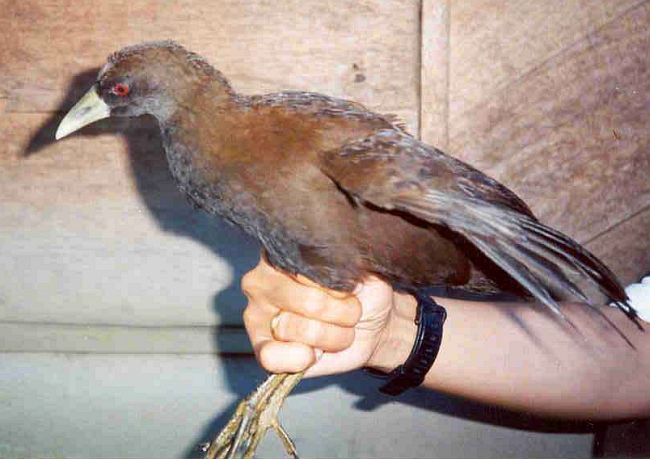| Citation |
|
Description |
Geographic Range [top]
Range Description: Amaurornis magnirostris was only recently described, and is currently known only from Karakelang (=Karakelong) Island in the Talaud Archipelago, Indonesia, where it is sympatric with Rufous-tailed Waterhen A. moluccana (Lambert 1998). The population is estimated at 2,350-9,560 individuals (Riley 2003). It may also occur on neighbouring islands, in particular Salibabu (=Salebabu) and Kabaruang (Lambert 1998), but less than 20 km2 of forest occurs on these two islands, much of it degraded (Riley 2003).
Countries occurrence:
Native:
Indonesia
Additional data:
? Continuing decline in area of occupancy (AOO): Yes
? Extreme fluctuations in area of occupancy (AOO): No ? Estimated extent of occurrence (EOO) - km2: 1200
? Continuing decline in extent of occurrence (EOO): Unknown ? Extreme fluctuations in extent of occurrence (EOO): No
? Continuing decline in number of locations: Unknown
? Extreme fluctuations in the number of locations: No
Range Map: Click here to open the map viewer and explore range.
Population [top]
Population: Riley (2003) estimated the population to number 2,350-9,560 individuals, thus here it is placed in the band for 2,500-9,999 mature individuals. This roughly equates to 3,750-14,999 individuals in total, rounded here to 3,500-15,000 individuals.
Trend Justification: The species is suspected to be in decline owing to hunting and forest degradation. The likely rate of decline, however, has not been estimated.
Current Population Trend: Decreasing
Additional data:
? Number of mature individuals: 2500-9999 ? Continuing decline of mature individuals: Yes
? Extreme fluctuations: No ? Population severely fragmented: No
? No. of subpopulations: 1 ? Continuing decline in subpopulations: Unknown
? Extreme fluctuations in subpopulations: No ? All individuals in one subpopulation: Yes
? No. of individuals in largest subpopulation: 100
Habitat and Ecology [top]
Habitat and Ecology: It is a forest species, but also occurs at lower densities in rank vegetation, scrub, and overgrown plantations up to 3 km from the forest edge (Lambert 1998, Riley 2003), and has been reported from wet swampy habitat (N. Dymond in litt. 2009).
Systems: Terrestrial
Continuing decline in area, extent and/or quality of habitat: Yes
Generation Length (years): 3.7
Movement patterns: Not a Migrant
Threats [top]
Major Threat(s): Approximately 350 km2 of primary forest remains on Karakelang, within two protected areas, but there has been no management and these areas are threatened by agricultural encroachment, illegal logging, and fire (Lambert 1998, Riley 2003). Rails are also trapped for food, but mainly outside forests (Riley 2003). Introduced rats, probably Ricefield Rat Rattus argentiventer, are present on Karakelang, and may also pose a threat (Lambert 1998, Riley 2003)
Conservation Actions [top]
Conservation Actions: Conservation Actions Underway
Approximately 350 km2 of primary forest remains on Karakelang, within two protected areas. Although 350 km2 of primary forest has some form of protected status on Karakelang, 250 km2 as a Wildlife Reserve, there is, at present, no management of these sites. Since 1995, the "Action Sampiri" project has been conducting fieldwork and conservation awareness programmes on the island. Introducing adequate protection measures to the newly gazetted Wildlife Reserve is the focus of a forthcoming four-year GEF project.
Conservation Actions Proposed
Survey neighbouring islands, in particular Salibabu (=Salebabu) and Kabaruang. Prevent illegal logging and hunting in the two protected areas within which this species occurs.
Citation: BirdLife International. 2016. Amaurornis magnirostris. The IUCN Red List of Threatened Species 2016: e.T22732147A95043197. http://dx.doi.org/10.2305/IUCN.UK.2016-3.RLTS.T22732147A95043197.en. Downloaded on 17 October 2018.
Disclaimer: To make use of this information, please check the .
Feedback: If you see any errors or have any questions or suggestions on what is shown on this page, please provide us with feedback so that we can correct or extend the information provided
|

